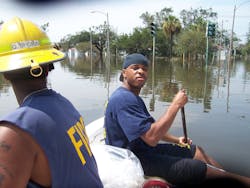New Orleans Firefighter Helped Rescue His Family During Katrina
While many New Orleans rescuers were unsure of the fate of their families following Hurricane Katrina, Firefighter Kenyon Hughes knew they were safe--after he helped rescue them from an upper floor of a flooded apartment building.
Firefighters assigned to Engine 21 spent that afternoon assisting residents who needed to evacuate the Saint Bernard neighborhood before they brought their mattresses, clothing and other supplies to the pre-determined staging point at the Fair Grounds Race Course.
As the storm blew through, firefighters on the first floor began to find water coming in and moved to the second floor. They were able to watch the winds push trees down and dump massive amounts of rain.
After the winds subsided, Hughes and a group of firefighters were told to take a pumper to conduct a windshield survey of the neighborhood. This systematic size-up of the would assess damage and help commanders understand the resources they would need.
“We couldn’t even get out of the fairgrounds because the water was so high,” Hughes recalled, noting that there was more than two feet of water surrounding the property.
They returned to the grand stands at the fairgrounds and were able to get high enough to see that the entire area around them was flooded. They did not have boats.
“At that point, it was time to go into survival mode,” Hughes, who had four years on the department at the time, recalled.
From their elevated vantage point, they were able to find several boats in yards. They wadded through the neck deep water to find that some did not have motors, and those with motors did not have keys, so the firefighters had to improvise.
“We had some guys hot wire the boats to get them started. We tore apart fences and took the planks of wood to use as oars. Other firefighters had to siphon gas from cars in the parking lot to get gasoline so that we could fill the boats or bring it with us.”
Hughes was at the front of the boat, using a broomstick to feel for obstacles under the water including cars, street signs and other debris that was floating.
It wasn’t long before they started finding residents who were trapped by water that was five to six feet deep. But, without the ability to communicate with other rescuers, they were unaware of any safe location to drop off residents.
They spotted a helicopter that was landing nearby and followed it back to St. Bernard Avenue at I-610 where they spotted evacuees on the bridge.
As rescue efforts continued for two to three days, Hughes had his family, who lived around that neighborhood, on his mind. That included his sister and nephew, whose disability would require medical assistance.
“It was by the luck of God...when we got to the interstate she was screaming and hollering to me,” he said. She was able to evacuate with the her son, but the rest of the family was holed up on the third floor of a nearby building.
“It was my dad, my mom, my auntie, my grandma...it was about 20 of them.”
By the time they removed them all to the interstate, his sister and nephew had been transported from the bridge to a medical facility to get the assistance he needed.
Once they were all on the the interstate, Hughes talked with a police officer to help keep his family together when they were evacuated by helicopter. They would eventually be taken to Baton Rouge to stay with family.
“After that, I was straight. I was able to really focus on helping everyone else.”
Hughes said people were yelling out to them, asking to get rescued. Sometimes they would shoot guns into the air to get the rescuers attention.
“We can only do so much, sometimes we knew we had had to go get the elderly people and tell others to stay cool, that we would be back.”
The rescues continued from sun up until sun down for four or five days.
As they continued to siphon gas for their boats, they encountered fuel that was mixed with water and the motors were rendered useless.
Stranded by high waters and unable to get out, they painted help on the fairground property and set their mattresses on fire to get the attention of U.S. Coast Guard crews.
A helicopter arrived and evacuated the crew, who were then transported to the west bank to be reunited with other firefighters.
